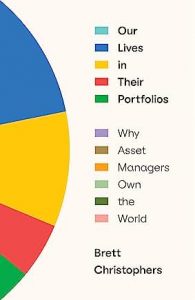Brett Christophers has become the leading expert on the role the financial sector has played in shaping the UK economy – for better or worse, usually the latter. I first came across his 2013 Banking Across Boundaries, where he was the first person to point out the pernicious effect of the ‘FISIM’ (financial intermediation services indirectly measured) construct in flattering the contribution of finance to the economy – a point later taken up by others. Subsequent books have looked at UK land ownership (The New Enclosure) and rentiership (Rentier Capitalism).
His new book, Our Lives In Their Portfolios: Why asset managers own the world, lives up to the high expectations established by the earlier ones. The subject is the scale and scope of the ownership of physical infrastructure – mainly in the UK but with examples from the US and Australia too – by large and generally little-known asset managers. Take Kent for example: water and wastewater infrastructure is controlled by Macquarie and Morrison, while the gas network is owned by Global Infrastucture Partners and Brookfield. Blackstone, Harrison Street and Safanad own much housing. EQT Partners owns the charging stations for electric vehicles. And so on.
In short, a group of global asset management companies act for investors such as pension funds and companies, creating funds that invest in real assets and buy in services to operate them. However, while the investors have long term horizons and look for steady returns (such as rents or fee income), and the infrastructure itself is long-lived, the funds set up by the asset managers coming in between are short term – a few years at most. Ownership of the assets by different managers churns frequently, and the managers have every incentive to cut maintenance costs and raise charges or rents. As all the operational aspects are contracted out to service companies, the asset managers are neither energy or water companies, nor investors in such companies: they are pure rentiers. The risks are borne entirely by others – and particularly the people experiencing crumbling homes or essential services.
Despite the large impact this subterranean ownership structure therefore has on people’s lives – through lack of maintenance and repairs and rising costs – there is scant public information. One of the major contributions of the book is the evidently huge amount of work that has gone into stitching together what information is available: “Researching and writing about asset-manager society is sometimes much more like detective work than it should be.” There is a shout-out here to the FT’s Jonathan Ford, who has done some excellent reporting on various UK rentiership scandals. The book organises the material by considering the asset classes (housing, energy, farm land, transport), the geography (where are the investments mainly located – US, UK – and where do the asset managers headquarter), and who are the major commercial players.
PFI projects clearly boosted the asset manager business no end, and there are continuing pressures for the government to bring more private long term investment into infrastructure, given that the state has seemingly abdicated from such investments in the country’s future. While I don’t have a problem with the idea of private money coming into infrastructure investment, there is a clear incentive issue: as Avner Offer’s excellent recent (2022) book Understanding the Private-Public Divide set out, private money will always require pay-back faster than a major piece of infrastructure can deliver, so there are challenges in structuring the investment and governance. And the lack of transparency and failures of governance over the maintenance and operation of infrastructure and housing, resulting from the financialized structure of the investment through asset managers, are shocking. I defy anyone to read this book without being at least a bit scandalized about the blatant disregard for the people using these essential services.
What to do about it? Not clear, but the first step is clearly the disinfectant of light. Our Lives in Their Portfolios is an essential start. The book is out in late April.

